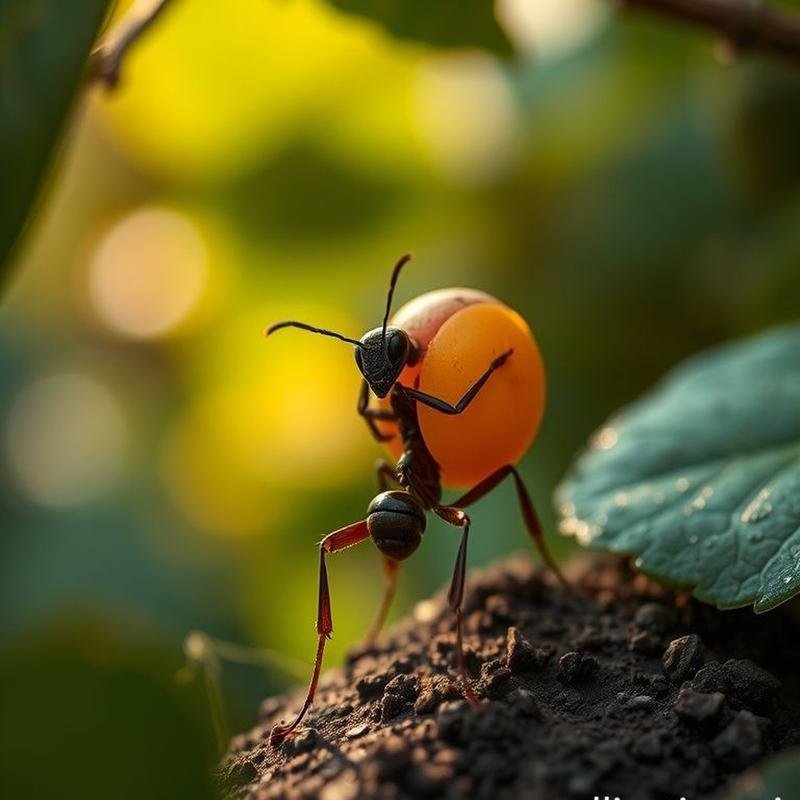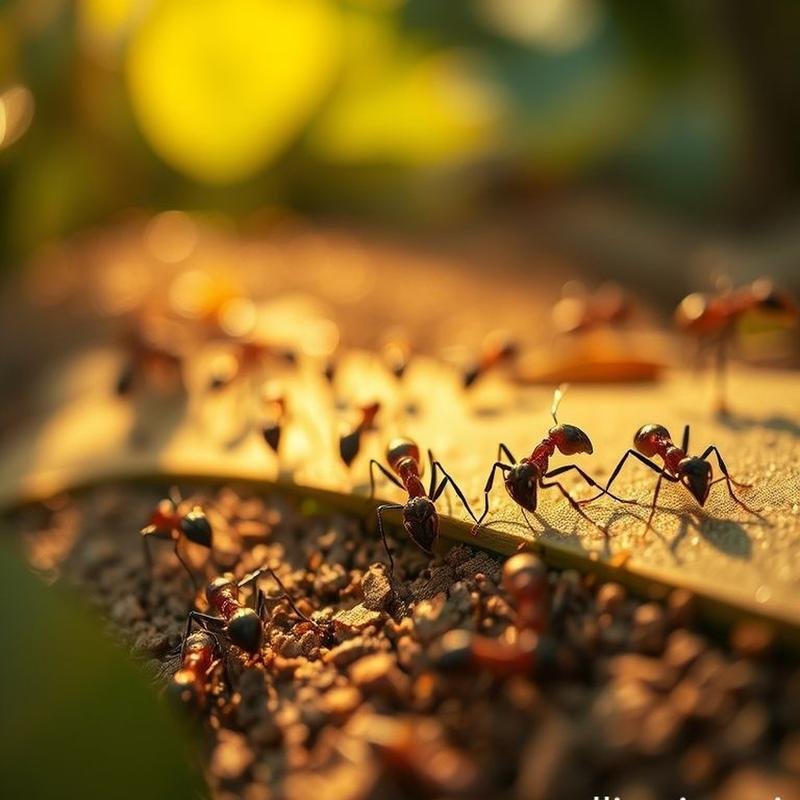Ant Colonies: A Potential Solution to the Climate Crisis? 🐜🌱 Ingenious Solutions.

Ant Colonies: Climate Crisis Solutions?
Did you know that certain architects, devoid of formal qualifications and blueprints, construct cities that surpass our own in complexity and sustainability? This episode embarks on an exploration of the remarkable world of ants, examining how their collective intelligence can provide unexpected solutions to the climate change crisis threatening Arab urban centers. Can we truly reimagine a sustainable future, drawing inspiration from these diminutive creatures?
Before we delve into this compelling investigation, share your predictions on how ant societies can inform the design of future cities. And please subscribe to our documentary channel to join us as we explore this fascinating series.
Swarm Intelligence: The Key to Ant Architecture
But how do ants achieve these astonishing architectural feats? The key lies in swarm intelligence, a compelling concept that offers solutions to contemporary challenges. An ant colony is not simply a kingdom ruled by a single entity, but a complex network of decentralized interactions, a dynamic living system. No ant possesses a degree in architecture; rather, each individual is an integral component of a larger system, making decisions collectively in a remarkable manner.
Pheromones: The Language of Ants
Pheromones constitute the ants’ sophisticated communication system, subtle chemical trails deposited to guide their counterparts. Imagine an ant discovering a substantial food source. Upon its successful return, it leaves a faint pheromone trail. Other ants, driven by curiosity and hunger, follow this trail, and the more ants that traverse the same path, the stronger the chemical trace becomes, thereby enhancing its attractiveness. The shortest path is invariably optimal, as time represents valuable energy, and the shortest path translates to a higher concentration of pheromones, resulting in greater efficiency. This simple yet ingenious process creates what is known as ant colony optimization, a phenomenon worthy of rigorous study. The double-bridge experiment clearly demonstrates this capability; even with sudden changes in distance, the ants consistently identify the shortest path with remarkable efficiency, adapting rapidly to new and evolving conditions.
Ant Cities: Architectural Masterpieces
This algorithm transports us to the heart of the earth, where architectural masterpieces unfold, rivaling the grandeur of the Giza pyramids. Here, within the depths of ant cities, we uncover a natural engineering prowess, constructed with a logic of efficiency and sustainability that inspires profound admiration. Consider an abandoned city in the heart of Brazil, spanning a vast area of 50 acres, housing nearly 8 tons of soil transported with meticulous precision. This magnificent structure, built by ants, reveals engineering capabilities that transcend conventional limitations, featuring a complex network of tunnels and chambers extending 5 meters below the earth’s surface. However, the miracle resides not only in the sheer scale but also in the intricate details that reflect design ingenuity.
Ants, for example, possess a sophisticated ventilation system within their nests, with ventilation openings specifically designed to maintain consistent temperature and humidity, mirroring the capabilities of modern air conditioning engineers. Certain ant species, such as fire ants, construct robust floating rafts from their compacted bodies to safeguard the colony from devastating floods, an impressive survival strategy inspired by cutting-edge natural disaster management solutions. Argentine ant colonies transcend national borders, sometimes extending over 8,000 square kilometers, demonstrating impressive global overlap and cooperation.
Climate Change: A Threat to Our Cities
However, these ant cities are not the only entities facing the threat of extinction. Our own cities, these vast human settlements, stand at a critical juncture. Climate challenges are intensifying, placing immense pressure on the Arab world. Rising temperatures are not merely fleeting figures in news reports, but a tangible reality that scorches us. Stark studies indicate that the Middle East and North Africa region is experiencing a faster-than-average global rise, with an increase of 1.5 degrees Celsius since the beginning of the 20th century. This translates to longer and harsher summers, and increased strain on our limited resources. Water, the lifeblood, has become a scarce and invaluable commodity. By 2030, dire predictions indicate that 80-90% of the region’s population will face severe shortages. Imagine cities suffering from extreme thirst, and bitter conflicts exacerbated by a single drop of water. But the crisis does not end there. Coastal cities, such as Cairo and Alexandria, are threatened by the imminent danger of rising sea levels, a looming threat to infrastructure and entire communities. Devastating floods, as witnessed in Jeddah, have become recurring nightmares, claiming innocent lives and destroying property. Desert cities like Dubai are struggling valiantly to meet the growing demand for energy to power air conditioning systems, thereby contributing to the problem. Deadly heat waves are ravaging vulnerable populations, further exacerbating the situation.
Ant-Inspired Solutions for a Sustainable Future
Amid these immense challenges, an unexpected beacon of hope emerges. Hope that originates not from complex technology, but from the depths of nature itself – the world of ants. Imagine natural air conditioning systems, inspired by termite mounds, underground structures that maintain cool building temperatures even in extreme heat, resulting in significant energy savings. Envision smart, decentralized transportation networks, learning from the foraging strategies of ants, reducing congestion and facilitating smooth traffic flow. Indeed, the collective intelligence of ants can inspire us to design decentralized water supply networks, flexibly adapting to climate fluctuations and ensuring access to clean water for every household. And waste management systems that mimic ants’ sorting of organic materials, transforming waste into valuable resources.
Rigorous scientific studies, published in prestigious journals such as Science, confirm that algorithms inspired by ant behavior can improve traffic management and reduce carbon emissions. It is time to view these small creatures with new eyes, eyes that recognize sustainable solutions for the future of our cities.
Ant Wisdom in the Arab World
It is time to reconsider these small creatures, to see them with eyes that recognize sustainable solutions for the future of our cities. Now, let’s turn our attention to the Arab world, where the wisdom of ants is becoming a tangible reality. In Masdar City in Abu Dhabi, a pioneering project is underway that seeks to create a fully sustainable urban environment. Here, cooling technologies draw inspiration from the ingenious strategies of desert ants, reducing the need for air conditioning by up to 75%.
In Morocco, the National Center for Water and Energy Research is investigating building materials designed like ant nests, seeking to fortify structures against extreme heat and humidity. Meanwhile, in Jordan, the Sustainable Smart Cities Initiative has adopted solutions derived from ant behavior to revolutionize water resource management, collecting and distributing precious rainwater efficiently. These are not merely projects; they serve as compelling testimonies to the power of nature to inspire innovative solutions in the face of the most pressing challenges.
A Future Inspired by Ants
The future of sustainable cities… a vision inspired by ants. And here we stand on the threshold of a bright future, a future in which our cities can truly breathe and flourish, inspired by the profound wisdom of tiny creatures. Imagine vibrant cities, utilizing ant-inspired algorithms to manage traffic seamlessly, eliminate frustrating bottlenecks, and improve the flow of daily life for every individual. This is not a flight of science fiction, but a tangible reality already being implemented in some forward-thinking cities. Imagine towering buildings rising towards the sky, employing an ingenious natural ventilation system that mimics complex termite mounds, as exemplified by the innovative engineer Mick Pearce in Zimbabwe, drastically reducing energy consumption and preserving our planet. Imagine decentralized and resilient energy networks, mirroring the way diligent ants organize to collect food, making our cities more resilient to natural disasters and sudden power outages, ensuring that life continues smoothly even in the most challenging circumstances. This radical transformation extends to how we manage increasing waste. We can learn significantly from ants that skillfully convert organic waste into rich compost, and apply these intelligent principles to substantially reduce waste and improve the management of valuable resources in our cities. Ant Colony Optimization algorithms, directly inspired by the cooperative foraging behavior of ants, can assist us in identifying the optimal strategic locations for electric charging stations, and designing more efficient and sustainable public transportation networks.
The concept of Stigmergy, that exquisite method by which ant colonies communicate by modifying the surrounding environment, opens up vast horizons for us to design interactive and flexible urban spaces, capable of adapting to the variables of the future.
It has become unequivocally clear that ants offer valuable lessons in the field of sustainable urban planning. Their remarkable self-organization, and their superior ability to solve problems collectively, represent a model to be emulated. Ant Colony Optimization (ACO) technology and the concept of Biomimicry, are powerful tools capable of transforming our cities into more efficient and resilient environments, capable of withstanding climate challenges. Let us be inspired by these small creatures, and let us adopt innovative solutions to address the growing climate challenges facing our Arab world.
Following our compelling exploration of the world of ants and their intelligent solutions, the question remains: how can we implement these ant-inspired solutions in our Arab cities to address the challenges of climate change? Share your thoughts and suggestions in the comments!










